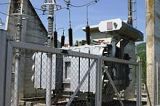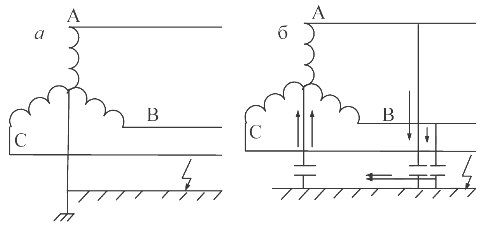Modes of operation of the neutrals of the transformers of the power system
 Transformers have neutrals whose mode of operation or method of working earthing is due to:
Transformers have neutrals whose mode of operation or method of working earthing is due to:
- requirements for safety and labor protection of personnel,
- permissible earth fault currents,
- overvoltages resulting from earth faults, as well as the operating voltage of the intact phases of the electrical installation relative to the earth, which determine the level of insulation of electrical devices,
- the need to ensure reliable operation of the grounding relay,
- the possibility of using the simplest schemes of electrical networks.
In the case of a single-phase earth fault, the symmetry of the electrical system is broken: the phase voltages relative to the ground change, earth fault currents appear, overvoltages occur in networks. The degree of symmetry change depends on the neutral mode.
The neutral mode has a significant impact on the operating modes of electrical receivers, power system schemes, parameters of the selected equipment.
Mains neutral It is a set of interconnected neutral points and conductors that can be isolated from the mains or connected to earth through low or high resistance.
The following neutral modes are used:
-
deaf grounded neutral,
-
isolated neutral,
-
effectively grounded neutral.
The choice of neutral mode in electrical networks is determined by the continuous supply of consumers, reliability of work, safety of service personnel and efficiency of electrical installations.
Neutrals of transformers of three-phase electrical installations, to the windings of which electrical networks are connected, can be earthed directly by inductive or active resistance or isolated from earth.
If the neutral of the transformer winding is connected to the grounding device directly or through a low resistance, then this neutral is called blindly grounded, and the networks connected to it, respectively, networks with a grounded neutral.
A neutral that is not connected to an earthing device is called an isolated neutral.
Networks, the neutral of which is connected to the grounding device through a reactor (inductive resistance), which compensates for the capacitive current of the network, are called networks with a resonantly grounded or compensated neutral.
Networks whose neutral is grounded through a resistor (resistance) is called a network with a resistively grounded neutral.
Electric network with a voltage higher than 1 kV, where the earth fault factor does not exceed 1.4 (the earth fault factor is the ratio of the potential difference between the undamaged phase and the ground at the point of an earth fault of another or two other phases to the potential difference between the phase and the ground at that moment before closing) is called network with effectively grounded neutral.
Electrical installations, depending on electrical safety measures, are divided into 4 groups:
- electrical installations with voltages above 1 kV in networks with an effectively grounded neutral (with high earth fault currents),
- electrical installations with a voltage over 1 kV in networks with an isolated neutral (with low grounding currents),
- electrical installations with a voltage of up to 1 kV with a grounded neutral,
- electrical installations with voltage up to 1 kV with isolated neutral.
Neutral modes of three-phase systems
Voltage, kV Neutral mode Note 0.23 Deaf grounded neutral Safety requirements. All electrical enclosures are grounded 0.4 0.69 Isolated neutral To improve power supply reliability 3.3 6 10 20 35 110 Effectively grounded neutral To reduce the voltage of open phases to ground when one phase is shorted to ground and reduce the rated insulation voltage 220 330 500 750 1150
Systems with a blind earthed neutral are systems with a high earth fault current. In the event of a short circuit, the short circuit is automatically disconnected. In 0.23 kV and 0.4 kV systems this shutdown is dictated by safety requirements. All equipment frames are grounded simultaneously.
Systems 110 and 220 kV and above are implemented with an effectively grounded neutral… In the event of a short circuit, the short circuit is also tripped automatically. Here, grounding the neutral leads to a reduction in the rated insulation voltage. It is equal to the phase voltage of the undamaged phases to ground. To limit the magnitude of earth fault currents, not all transformer neutrals are earthed (effective earthing).

Neutral modes of three-phase systems: a — grounded neutral, b — isolated neutral
Isolated neutral called neutral, not connected to an earthing device or connected through devices that compensate for the capacitive current in the network, voltage transformers and other high resistance devices.
A system with an isolated neutral used to improve the reliability of the power supply. It is characterized by the fact that when one phase is closed to the ground, the voltage of the phase conductors relative to the ground increases to line voltage, and the symmetry of the stresses is broken. Capacitive current flows between line and neutral. If it is less than 5A, then it is allowed to continue operation for up to 2 hours for turbine generators with a power of up to 150 MW and for hydro generators - up to 50 MW. If it is found that the short circuit did not occur in the generator winding, but in the network, then work is allowed for 6 hours.
Networks from 1 to 10 kV are networks with generator voltage of power plants and local distribution networks. When one phase is grounded in such a system, the voltage of the undamaged phases relative to the ground increases to the value of the network voltage. The insulation must therefore be rated for this voltage.
The main advantage of the isolated neutral mode is the ability to supply energy to feeder consumers and consumers with a single-phase earth fault.
The disadvantage of this mode is the difficult detection of the location of the earth fault.
The increased reliability of the mode (that is, the possibility of normal operation in the event of single-phase earth faults, which make up a significant part of the breakdown of electrical equipment) of the isolated neutral leads to its mandatory use at voltages above 1 kV up to and including 35 kV, as these networks supply large groups of consumers and consumers of energy.
From a voltage of 110 kV and above, the use of an isolated neutral mode becomes economically unprofitable, since the increase in voltage relative to the ground from phase to line requires a significant increase in phase isolation. The use of isolated neutral mode up to 1 kV is allowed and justified by increased requirements for electrical safety.
Read also: The use of electrical networks with an isolated neutral
